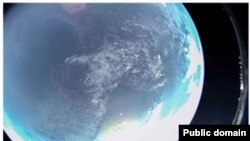ເກົາຫຼີເໜືອ ໄດ້ໃຫ້ຮ່ອງຮອຍວ່າ ຕົນໄດ້ທົດລອງ ລະບົບຍ່ອຍຂອງແຜນການສອດແນມທາງດາວທຽມ ໃນວັນອາທິດວານນີ້ ທີ່ໄດ້ພາໃຫ້ມີຄວາມເປັນຫ່ວງເພີ້ມຂຶ້ນວ່າປະເທດດັ່ງກ່າວອາດໃຫ້ຮ່ອງຮອຍຕື່ມກ່ຽວກັບການທົດລອງລູກສອນໄຟໄລຍະໄກ ທີ່ຈະຕິດຕາມມາ.
ອົງການຂ່າວສູນກາງຂອງເກົາຫຼີເໜືອ ຫຼື (KCNA ໄດ້ກ່າວໃນວັນຈັນມື້ນີ້ວ່າ “ການທົດລອງທີ່ສຳຄັນ ໄດ້ໃຫ້ການຢືນຢັນ ກ່ຽວກັບ ລັກສະນະຂອງລະບົບ ກ້ອງຖ່າຍຮູບທີ່ໃຫ້ຄວາມກະຈ່າງແຈ້ງສູງຂອງຮູບພາບ (ທີ່ຈະນຳເຂົ້າໃສ່ດາວທຽມ) ລະບົບການສົ່ງຂໍ້ມູນແລະເຄື່ອງມືຄວບຄຸມລະດັບຄວາມສູງແລະຄວາມຖືກຕ້ອງໃນການປະຕິບັດງານຂອງມັນ.” ການທົດລອງໄດ້ເປັນທີ່ “ສຳຄັນ ຍິ່ງໃຫຍ່” ທີ່ໄດ້ກ່າວວ່າ ຄວບຄຸມໂດຍຫ້ອງການພັດທະນາອະວະກາດແຫ່ງຊາດ ແລະສະຖາບັນວິທະຍາສາດປ້ອງກັນປະເທດຂອງເກົາຫຼີເໜືອ.
ຮູບພາບສອງທີ່ໄດ້ນຳອອກເຜີຍແຜ່ ພ້ອມດ້ວຍຖະແຫຼງການ ທີ່ສະແດງໃຫ້ເຫັນວີວ ຢ່າງກວ້າງຂວາງຂອງແຫຼມເກົາຫຼີ ຈາກວົງໂຄຈອນເທິງອະວະກາດ ປຽບທຽບໃສ່ກັບຮູບພາບຂະຫຍາຍເຂົ້າມາໃກ້ທີ່ເຫັນຢ່າງຈະແຈ້ງຈາກກ້ອງຖ່າຍໂດຍດາວທຽມ.
ທ່ານປາກ ວົນ-ກອນ ອາຈານທີ່ສຶກສາຄົ້ນຄວ້າກ່ຽວກັບເກົາຫຼີເໜືອ ຢູ່ມະຫາວິທະຍາໄລອີວຮາ
ວູແມນສ໌ ໃນນະຄອນໂຊລ ກ່າວວ່າ “ສ່ວນສຳຄັນທີ່ສຸດຂອງດາວທຽມສອດແນມ ກໍຄືກ້ອງຖ່າຍ
ຮູບ. ອີກອັນນຶ່ງແມ່ນກົນໄກໃນການສົ່ງ.”
ກອງທັບເກົາຫຼີໃຕ້ ແລະຍີ່ປຸ່ນ ໄດ້ກ່າວໃນຕອນເຊົ້າວັນອາທິດ ວານນີ້ວ່າ ລູກສອນໄຟທີ່ຍິງທົດລອງຄັ້ງທີແປດຂອງເກົາເໜືອປີນີ້ ແລະເທື່ອທຳອິດ ນັບແຕ່ ເສດສິ້ນການແຂ່ງຂັນກິລາໂອລິມປິກລະດູໜາວຢູ່ປັກກິ່ງ ແມ່ນມີທ່າທາງວ່າເປັນລູກສອນໄຟາຂີປະນາວຸດ.
North Korea indicated it had conducted a subsystems test for a planned reconnaissance satellite Sunday, raising concerns the state could be hinting at a more consequential long-range missile test.
North Korea’s Korean Central News Agency (KCNA) said Monday the “important test... confirmed the characteristics of the high-resolution camera system [to be loaded onto the satellite], data transmission system and attitude control devices and the correctness of their performance." The test was of "great significance," it said, overseen by the National Aerospace Development Administration and the Academy of Defense Sciences of North Korea.
Two images released with the statement showed a wide view of the Korean peninsula from orbital space, versus a zoomed in high-resolution capture by a satellite camera.
"The most important feature for a spy satellite is its camera," notes Park Won-gon, North Korean Studies professor at Ewha Womans University in Seoul. "The other is the launching mechanism."
South Korean and Japanese militaries had said Sunday morning's projectile launch, North Korea's eighth test this year and the first since the end of the Beijing Winter Olympics, was likely a ballistic missile.





